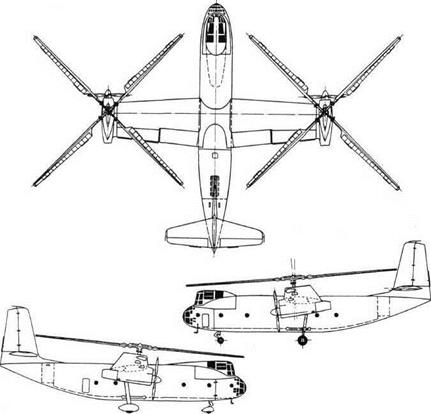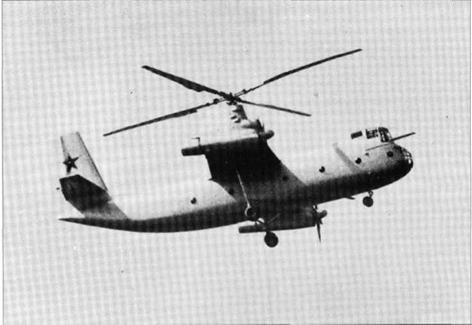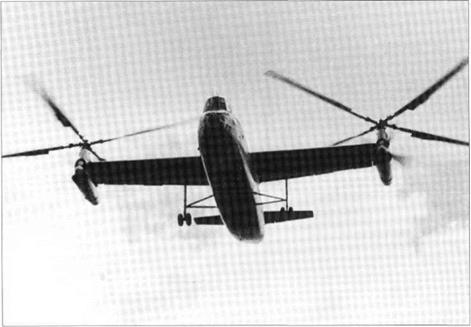Kamov Ka-22
![]()


Purpose: To create a Vintokryl (screw wing) compound helicopter.
Design Bureau: OKB ofNikolai Kamov, Moscow.
In 1951 various attempts were being made to increase the effective range of helicopters, notably by towing them in the outward direction behind an Li-2, with the lifting rotor au- torotating. The idea occurred to Kamov designer Vladimir Barshevsky that it would be possible to dispense with the tug aircraft if a helicopter could be provided with wings and an aeroplane propulsive system. After obtaining permission from Kamov, his deputy V V Nikitin took a proposal to the Kremlin and in a matter of days the OKB had a Stalin directive to get started. The engines were to be TV-2 (later TV-2VK) turboshafts supplied by N D Kuznetsov, and many organizations were involved in research for this challenging pro
ject, starting with model tests in the T-l 01 tunnel at CAHI. The final go-ahead was issued on 11 th June 1954. An order for three Ka-22s was placed on the factory at Ukhtomskaya, which had been derelict since Kamov was evacuated from there in October 1941. Concentration on the small Ka-15 (the OKB’ sfirstproduction helicopter) and other problems so delayed the programme that on 28th March 1956 prototypes 2 and 3 were cancelled. In June 1958 the LD-24 rotor blades began testing on an Mi-4. The Ka-22 itself first lifted from the ground on 17th June 1959, and made its first untethered flight on 15th August 1959, the test crew being led by pilot D K Yefremov. Serious control difficulties were encountered, and the Kamov team were joined by LII pilots VVVinitskii and YuAGarnayev. Though still full of problems the Vintokryl was demonstrated on llth October 1959 to MAP Minister PVDement’yev and WS C-in-C
KAVershinin. Gradually difficulties were solved and in July 1960 an order was received to manufacture three Ka-22s at GAZ No 84 at Tashkent, with D-25VK engines. On 23rd May 1961 a speed of230km/h was held for 37 minutes. On 9th July 1961 the Ka-22 caused a sensation at the Aviation Day at Tushino. On 7 th October 1961, with spats over the wheels and a fairing behind the cockpit, a class speed record was set at 356.3km/h (221.4mph), followed on 12th October by 336.76km/h (209.3mph) round a 100km circuit. The spats and fairing were then removed and on 24th November 1961 a payload of 16,485kg (36,343 Ib) was lifted to 2,557m (8,389ft). Preparations were then made to ferry AM 0I – 01 and the third machine AM 0I-03 from Tashkent to Moscow for Nil acceptance testing. Both departed on 28th August 1962. While making an intermediate stop at Dzhusaly 0I-01 rolled to the left and crashed inverted, killing Y efremov and his crew of six. The cause was diagnosed as ‘disconnection of No 24 cable joint of the linkage with the starboard lift rotor collective-pitch control unit’. At Tashkent and in Turkestan the cable joints and cyclic-pitch booster brackets were inspected on 0I-02 and 0I-03 and found to be incorrectly assembled. Changing the direction of rotation of one lifting rotor did little at lower speeds and caused problems at higher speeds – ‘When’, said lead engineer V S Dor – dan, ‘Shockwaves off the blades sounded like a large machine gun’. To improve stability and controllability the complex AP-116 differential autopilot was installed, continuously sensing attitude and angular accelerations, feeding the KAU-60A combined flight-control unit. On 12th August 1964 the heavily instrumented 0I-03 took off on one of a series of tests conducted with WS (air force) and GVF (civil) crews. Take-off was in aeroplane mode, and 15 minutes later at 310km/h (193mph) the aircraft suddenly turned to the right, ‘not arrested by full rudder and aileron.. .the aircraft turned almost 180° when Garnayev intervened, considering the problem was differential pitch of the pro – pellers…turn rate slowed, but the aircraft pitched into a steep dive…the engineer jettisoned the flight-deck hatches, and one struck the starboard lift rotor causing asymmetric forces which resulted in separation of the entire starboard nacelle. Garnayev ordered the crew to abandon the aircraft’. Three survived, but Col S G Brovtsev, who was flying, and technician A F Rogov, were killed. By this time the Mi-6 heavy helicopter was in wide service, and the Ka-22 was ultimately abandoned. Several years later the two surviving machines, 0I-02 and 0I-04, were scrapped.
An article about the Ka-22 in Kryl’ya Rodiny (Wings of the Motherland) for November 1992 does not mention the fact that two crashed, which is not widely known even in the former Soviet Union.
The Ka-22 was basically an aeroplane with its engines on the wingtips, with geared drives to both propellers and lifting rotors. The airframe was all light alloy stressed-skin, the high wing having powered ailerons and plain flaps. The fuselage had a glazed nose, three – seat cockpit above the nose and a main cargo area17.9 x 3.1 x 2.8m (58′ 9" x10′ 2" x 9′ 2") for 80 seats or 16.5 tonnes of cargo. The entire nose could swing open to starboard for loading bulky items or a vehicle. The original prototype was powered by 5,900-shp TV-2VK engines, but these were later replaced by the 5,500-shp D-25VK. These had free turbines geared via a clutch to the main-rotor and via a front drive to the four-blade propeller and a fan blowing air through the oil cooler from a circular inlet above the nacelle. The two free – turbine outputs were interconnected by a 12- part high-speed shaft ‘about 20m long’. The main rotors were larger derivatives of those of the Mi-4. In helicopter mode the propeller drive was declutched and the flaps were fully lowered. Flight control was by differential cyclic and collective pitch. In aeroplane mode the lifting rotors were free to windmill and the aircraft was controlled by the ailerons and tail surfaces. The twin-wheel landing gears were fixed.

 Apart from prolonged dissatisfaction with the engines, the problems with the Ka-22 were mechanical complexity, severe losses in the gearboxes and drives and the fact that each lifting rotor blew straight down on top of the wing. Similar charges could be levelled against today’s V-22 Osprey.
Apart from prolonged dissatisfaction with the engines, the problems with the Ka-22 were mechanical complexity, severe losses in the gearboxes and drives and the fact that each lifting rotor blew straight down on top of the wing. Similar charges could be levelled against today’s V-22 Osprey.
|











